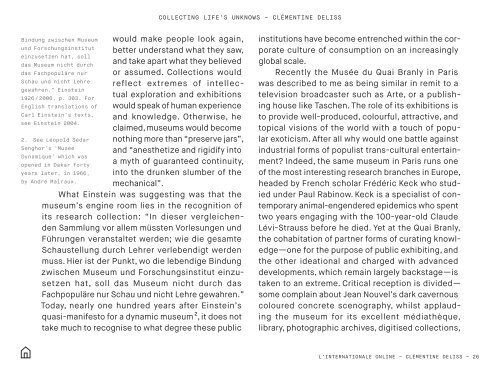DECOLONISING MUSEUMS
decolonisingmuseums-4
decolonisingmuseums-4
You also want an ePaper? Increase the reach of your titles
YUMPU automatically turns print PDFs into web optimized ePapers that Google loves.
COLLECTING LIFE’S UNKNOWS – CLÉMENTINE DELISS<br />
would make people look again,<br />
better understand what they saw,<br />
and take apart what they believed<br />
or assumed. Collections would<br />
reflect extremes of intellectual<br />
exploration and exhibitions<br />
would speak of human experience<br />
and knowledge. Otherwise, he<br />
claimed, museums would become<br />
nothing more than “preserve jars”,<br />
and “anesthetize and rigidify into<br />
a myth of guaranteed continuity,<br />
into the drunken slumber of the<br />
mechanical”.<br />
What Einstein was suggesting was that the<br />
museum’s engine room lies in the recognition of<br />
its research collection: “In dieser vergleichenden<br />
Sammlung vor allem müssten Vorlesungen und<br />
Führungen veranstaltet werden; wie die gesamte<br />
Schaustellung durch Lehrer verlebendigt werden<br />
muss. Hier ist der Punkt, wo die lebendige Bindung<br />
zwischen Museum und Forschungsinstitut einzusetzen<br />
hat, soll das Museum nicht durch das<br />
Fachpopuläre nur Schau und nicht Lehre gewahren.”<br />
Today, nearly one hundred years after Einstein’s<br />
quasi-manifesto for a dynamic museum 2, it does not<br />
take much to recognise to what degree these public<br />
Bindung zwischen Museum<br />
und Forschungsinstitut<br />
einzusetzen hat, soll<br />
das Museum nicht durch<br />
das Fachpopuläre nur<br />
Schau und nicht Lehre<br />
gewahren.” Einstein<br />
1926 / 2006, p. 303. For<br />
English translations of<br />
Carl Einstein’s texts,<br />
see Einstein 2004.<br />
2. See Léopold Sédar<br />
Senghor’s ‘Musée<br />
Dynamique’ which was<br />
opened in Dakar forty<br />
years later, in 1966,<br />
by André Malraux.<br />
institutions have become entrenched within the corporate<br />
culture of consumption on an increasingly<br />
global scale.<br />
Recently the Musée du Quai Branly in Paris<br />
was described to me as being similar in remit to a<br />
television broadcaster such as Arte, or a publishing<br />
house like Taschen. The role of its exhibitions is<br />
to provide well-produced, colourful, attractive, and<br />
topical visions of the world with a touch of popular<br />
exoticism. After all why would one battle against<br />
industrial forms of populist trans-cultural entertainment?<br />
Indeed, the same museum in Paris runs one<br />
of the most interesting research branches in Europe,<br />
headed by French scholar Frédéric Keck who studied<br />
under Paul Rabinow. Keck is a specialist of contemporary<br />
animal-engendered epidemics who spent<br />
two years engaging with the 100-year-old Claude<br />
Lévi-Strauss before he died. Yet at the Quai Branly,<br />
the cohabitation of partner forms of curating knowledge—one<br />
for the purpose of public exhibiting, and<br />
the other ideational and charged with advanced<br />
developments, which remain largely backstage—is<br />
taken to an extreme. Critical reception is divided—<br />
some complain about Jean Nouvel’s dark cavernous<br />
coloured concrete scenography, whilst applauding<br />
the museum for its excellent médiathèque,<br />
library, photographic archives, digitised collections,<br />
L’INTERNATIONALE ONLINE – CLÉMENTINE DELISS – 26


